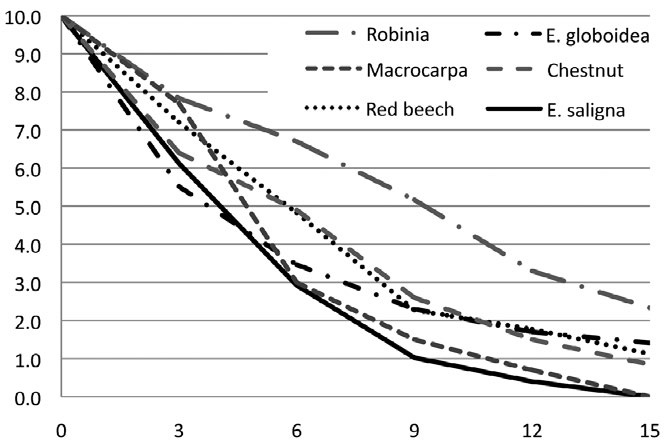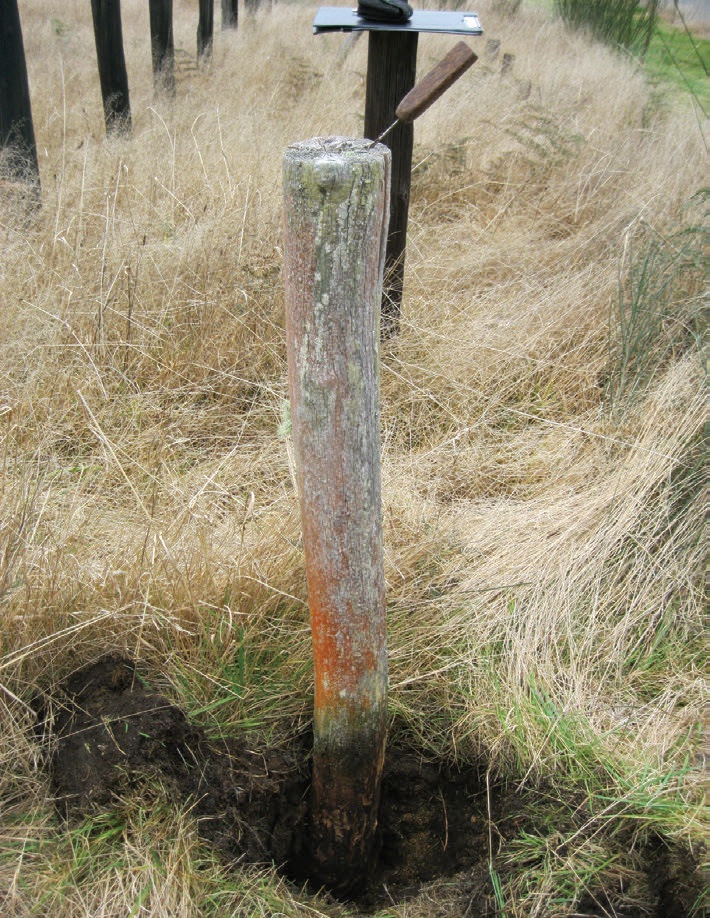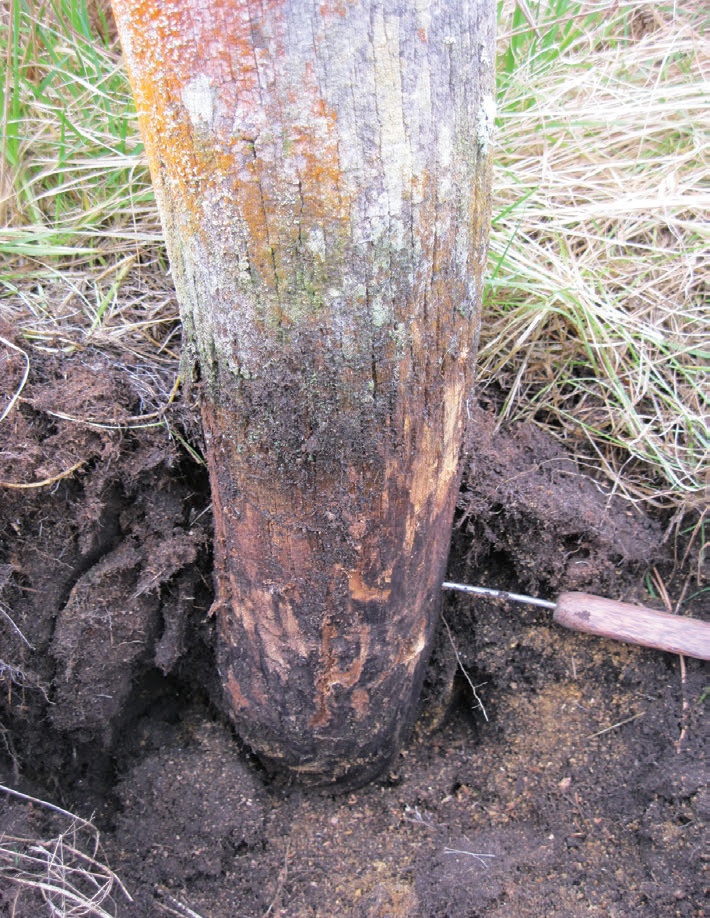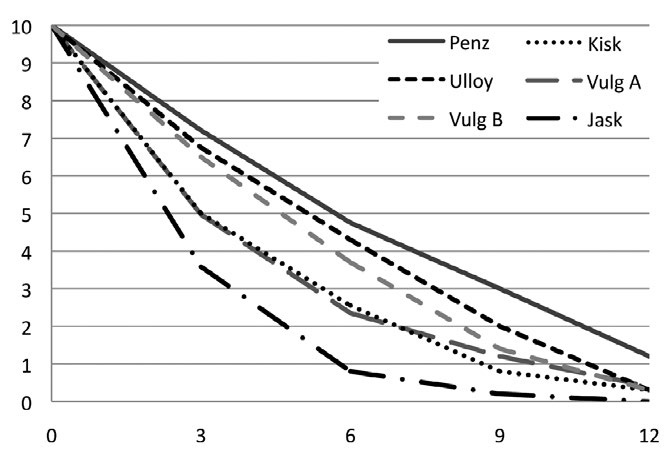The durability of robinia - Will young trees be suitable for posts?
Dave Page, Nick Ledgard and Tripti Singh, New Zealand Tree Grower November 2013.
Can young robinia be used as naturally durable posts with confidence? This article looks at whether they have greater durability than preservative-treated posts, and how length of growing time affects their effectiveness as posts.
Robinia Robinia pseudoacacia or black locust trees grown in New Zealand from seed have had relatively slow growth rates and poor form, making them an unattractive proposition for timber production. However, durability tests of heartwood from 40 to 60-year-old trees indicate that this is one of the few species that could be grown throughout the country for naturally durable posts.
In a test of split posts installed in the North Island in 1961, a total of 58 per cent were still in service after 26 years. In another test of debarked round robinia posts from 40-year-old trees installed in 1982, there had been no failures after 30 years.
In the late 1980s cuttings from selected Hungarian clones, supposed to be faster growing and of straight form, were imported and planted as rooted cuttings at Rangiora in October 1987. In June 1998, trees from several areas were felled and samples were taken from them for testing. While the trees were too small to yield useful timber, the durability of their heartwood was tested to determine their suitability for posts.
Compared with other species?
Before testing wood from young stems, from nine to 11 years old, numerous stake tests of older material had been installed to determine the durability classification of various locally grown species. The decay rates of several of the more durable species using 20 mm by 20 mm stakes are shown in the graph. The condition of stakes in durability tests is assessed annually using a simple point system where 10 means as new and 0 means failed. The average of the ratings for a group is the index of condition.

Robinia shows to be the best of the species tested. Red beech Nothofagus fusca, Eucalyptus globoidea and chestnut Castanea sativa have similar durability, but are less durable than robinia, while the macrocarpa and the E. saligna groups were the least durable.
Results from farm fence-line tests paint a slightly different picture. Tests set up in 1961 included split posts of robinia, E. saligna, red beech and sawn posts of macrocarpa. It found that red beech posts, a species traditionally used for fencing materials, were the most durable. Sawn macrocarpa heartwood posts had an average service life of about 15 years, with the first failures occurring after only five years.
Split E. saligna and robinia posts were of similar durability, the first posts failing in each group after nine or 10 years but the average life exceeding 20 years. Round posts from about 40-year-old robinia trees installed at Whakarewarewa have given much better results, with no failures and only moderate decay of five to 15 mm deep after 30 years.


The post shown above is cut from a stand of trees which were 30 to 40 years old. The sapwood had rotted away but none of the posts in this test group had failed. With the post shown on the right above the sapwood had rotted away and decay in the heartwood was generally 5 to 15 mm deep with occasional deeper pockets. The average life of the posts in this test is likely to exceed 40 years.
How durable is 9 to 11-year-old robinia?
The material for the tests came from three different sources
- A nine-year old spacing trial of trees which had been grown from seed collected at Woodend Beach, nominally called Vulgaris
- At Rangiora of an 11-year-old clonal trial where three trees were selected from each of the four best growing Hungarian clones – Jaszkeseri, Kiskunsagi, Penzesdombi and Ulloy
- A 17-year-old stand of trees grown on a farm site from locally collected seed and of similar size to the imported Hungarian clone trees.
Discs 1.4 metres above the ground, and 600 mm long butt billets, were cut from the trees. Details of measurements from the discs are in the table. The billets were cut up to provide 20 by 20 mm durability stakes and these were all heartwood. The Vulgaris stakes contained many defects, but those from the Hungarian clones were clearwood.
Details from breast height discs
| Group | Diameter at breast height under bark centimetres | Total number of growth rings | Heartwood | Basic density kg per cubic metre | |||
|---|---|---|---|---|---|---|---|
| Diameter centimetres | Growth rings number | Per cent | Heart | Sap | |||
| Jaszkeseri | 14.4 | 11 | 11.6 | 7 | 66 | 565 | 523 |
| Kiskunsagi | 15.0 | 10 | 11.4 | 7 | 57 | 616 | 605 |
| Penzesdombi | 15.1 | 10 | 12.3 | 8 | 65 | 686 | 655 |
| Ulloy | 13.7 | 9 | 11.0 | 6 | 64 | 659 | 655 |
| Vulgaris (9) | 8.8 | 8 | 5.9 | 4 | 45 | - | - |
| Vulgaris (17) | 13.8 | 13 | 9.1 | 8 | 44 | 604 | 612 |
Stake tests
Assessment results from robinia stakes installed in test sites at Rotorua and near Levin are in the graph below. These indicate that −
- The difference between the two Vulgaris groups was probably associated with age, but numerous defects in the Vulgaris A stakes could have increased decay rates.
- The Jaszkerseri groups had all failed after 10 years and had an average life of 4.4 years. The Kiskunsagi groups will have an average life of about seven years, as will the nine-year-old Vulgaris groups. The average life of the 17-year old Vulgaris will be about eight years, while that of the Ulloy and the Penzesdombi groups about nine and 10 years, respectively.
There was considerable variability within groups and between the two test sites. The first failures occurred after two years in the Vulgaris, Jaszkezeri and Kiskunsagi groups, after three years in the Ulloy groups and after four years in the Penzesdombi groups. At Waitarere only two stakes remain, both from the Penzesdombi group. After 12 years at Whakarewarewa, all of the Jaszkezeri stakes had failed but a few stakes remain in all other groups.
How long will posts from nine to 11-year-old trees last?
The Australasian durability classification scale has four divisions based on the in-ground durability of 50 mm square stakes. The scale and approximate equivalent average life for 20 by 20 mm stakes and 100 mm round heartwood only posts is given in the table.
Australasian durability classification equivalents
| Durability class | Average life | |||
|---|---|---|---|---|
| 50 mm stakes | 20 mm stakes | 100 mm posts | ||
| Class 1 | Very durable | Over 25 years | Over 10 years | Over 40 years |
| Class 2 | Durable | 15 to 25 years | 6 to 10 years | 25 to 40 years |
| Class 3 | Moderately durable | 5 to 15 years | 2 to 6 years | 10 to 25 years |
| Class 4 | Non-durable | Less than 5 years | Less than 2 years | Less than 10 years |
After 12 years the Penzesdombi and Ulloy stakes were approaching Class 1 durability, while the Vulgaris and the Kiskunsagi groups were almost certainly in Class 2. The Jaszkeseri stakes would be Class 3 durability. The table indicates that Jaszkezeri posts, with a heartwood diameter at the groundline of 100 mm, will have an average service life between 10 and 25 years, the first failures occurring in 5 to 10 years.
Similar posts from Vulgaris and Kiskunsagi trees may have an average life in excess of 20 years, but the first failures could occur within 20 years. Ulloy and Penzesdombi posts could have an average life over 25 years, but the first failures could be within 15 years.
The test stakes were from a very small sample of trees which had been grown on an ideal site. If the butt logs had been debarked and installed as posts they would have had a small end diameter between 12 and 18 cm with heartwood diameter of 10 to 15 cm, and only 8 to 10 cm for the Vulgaris.
The one-to-two centimetre deep sapwood on the outside would be likely to decay within five years, causing staples to fall out and loosening the posts in the ground. If the sapwood and bark was left on these posts they would require some maintenance, such as re-ramming and re-stapling, to ensure that they achieved their maximum service life.

Conclusion
The durability of heartwood from some Hungarian clones appears to be better than from other clones and superior to that of trees grown from local seed sources. Further tests using a larger sample to confirm durability and determine variation within clones are necessary before young robinia could be used as posts with confidence.
Even then, there is likely to be greater variation in durability than in preservative-treated posts. If robinia is to provide a useful source of posts, growing the trees for a longer period and cutting the logs to yield sawn or part-round posts may be preferable to cutting round posts from very young trees.
Dave Page is a Senior Technician with the Wood and Biofibre Group at Scion. Nick Ledgard is a retired scientist from Scion in Christchurch. Tripti Singh is a Scientist with the Wood and Biofibre Group at Scion.

 Farm Forestry New Zealand
Farm Forestry New Zealand